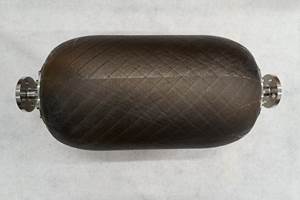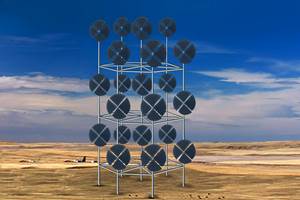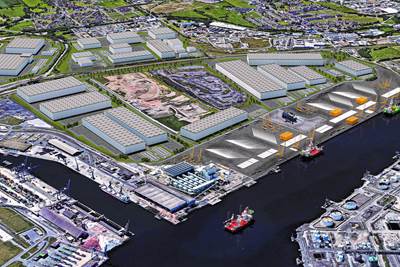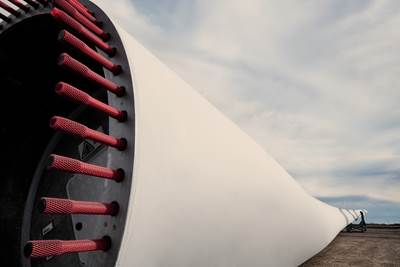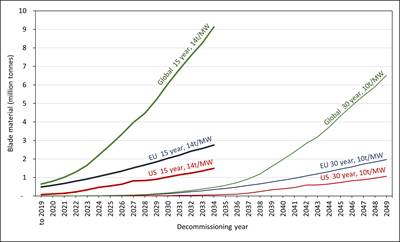Vineyard Wind offshore project receives federal approval
U.S. commercial-scale offshore wind farm design to include GE Haliade-X wind turbines for 800 MW of wind energy development in Massachusetts.
Share

Haliade-X wind turbine prototype. Photo Credit: GE Renewable Energy
On May 11 Vineyard Wind (New Bedford, Mass., U.S.), a joint venture between Avangrid Renewables (Portland, Ore., U.S.), a subsidiary of Avangrid Inc. (Orange, Conn., U.S.), and Copenhagen Infrastructure Partners (CIP, Copenhagen, Denmark) received the record of decision (ROD) from the U.S. Department of the Interior Bureau of Ocean Energy Management (BOEM), the final step in the federal review process for what is said will be the first commercial-scale offshore wind farm in the U.S.
“The record of decision is not about the start of a single project, but the launch of a new industry,” says Vineyard Wind CEO Lars T. Pedersen. “Receiving this final major federal approval means the jobs, economic benefits and clean energy revolution associated with the Vineyard Wind 1 project can finally come to fruition. It’s been a long road to get to this point, but ultimately, we are reaching the end of this process with the strongest possible project.”
Vineyard Wind 1 will be located 15 miles south of Martha’s Vineyard in Massachusetts. The 800-megawatt (MW) project will reportedly generate clean, renewable, cost-competitive energy for more than 400,000 homes and businesses across the Commonwealth and reduce carbon emissions by more than 1.6 million tons per year.

Photo Credit: Vineyard Wind 1
“Approval of the Vineyard Wind offshore project is a key step toward achieving the Biden administration’s goal of bringing 30 gigawatts [GW] of offshore wind online by 2030, and GE is excited to support that goal by providing our Haliade-X turbines, the most powerful offshore wind turbine built to date, for this project,” says John Lavelle, president & CEO, Offshore Wind at GE Renewable Energy (Paris, France). “The decision is one more reason to be optimistic about the potential of offshore wind in the U.S., an abundant source of clean, renewable energy that can help coastal communities address the threat of climate change and accelerate the energy transition.”
Since 2017, the Vineyard Wind 1 project has been through an unprecedented and exhaustive public review process that generated more than 30,000 public comments, more than 90% of which supported the project. The Construction and Operations Plan (COP) was reviewed by more than two dozen federal, state, and local agencies over the course of more than three and a half years.
The project design includes the GE Haliade-X, with a capacity of 13 megawatts (MW). The large turbine capacity has reportedly enabled the project to reduce the total number of turbines from 108 to 62 while still delivering a total capacity of 800 MW to Massachusetts ratepayers. The turbine layout, which features consistent spacing of one nautical mile between turbines, was endorsed by the United States Coast Guard for transit, fishing and navigational safety.
“With this record of decision on Vineyard Wind on the books, the era of American offshore wind is no longer on the horizon — it’s here, now, off the coast of Massachusetts, and the answer to America’s energy future is blowing in the offshore wind,” says U.S. Senator Edward Markey. “Vineyard Wind will be the first of many offshore wind projects to come.”
According to Speaker of the House Ronald J. Mariano, Massachusetts is now able to realize the ambitious offshore wind energy goals the legislature set in 2016. Further, he says, the House will continue to prioritize making Massachusetts a regional hub of the offshore wind industry, and most recently included a $10 million investment in the House budget to train the workforce that will fuel the offshore wind energy boom.
In response to comments and direct engagement with neighboring communities, environmental organizations and advocates, fisheries organizations and governmental and tribal entities, the project has incorporated significant mitigation measures, including:
- Historic Protections for the North Atlantic Right Whale (NARW):
-
Commitment to invest millions of dollars to develop and deploy innovative technologies and undertake scientific research to further safeguard marine mammals. Last year, Vineyard Wind partnered with Greentown Labs (Somerville, Mass., U.S.) to work with the startup community to innovative technologies to the forefront.
-
Institute comprehensive monitoring protocols to ensure that construction doesn’t take place when NARWs are near the lease area. The project will use acoustic monitoring technology throughout construction including in transit corridors and will employ trained protective species observers to spot NARW visually during transits and foundation installation.
-
Deploy industry-leading technology to dampen construction noise during installation in order to protect the NARW and all marine species.
-
- Substantial fisheries investment and mitigation funding:
-
Agreements with the states of Massachusetts and Rhode Island to provide millions to compensate fishermen for potential loss of revenue and gear and to enhance their ability to fish in and around the lease area.
-
Commitment to continue funding pre- and post-construction survey studies with both the University of Massachusetts Dartmouth School for Marine Science and Technology (SMAST) and the Massachusetts Lobstermen’s Association (MLA) to measure what impact, if any, the windfarm is having on the marine environment.
-
- Cultural and historical protections:
-
Project will use an Aircraft Detection Lighting System (ALDS) to ensure that nighttime lights will only operate a few hours a year when aircrafts are present.
-
Turbines will be painted to reduce visual impacts to historical properties.
-
Funds will be allocated to conduct ethnographic studies for local Native American tribes that will serve as the basis for submissions to the National Register of Historic Places to allow for greater recognition of tribal heritage sites.
-
Vineyard Wind will reach financial close in the second half of 2021 and begin delivering clean energy to Massachusetts in 2023.
Related Content
NCC reaches milestone in composite cryogenic hydrogen program
The National Composites Centre is testing composite cryogenic storage tank demonstrators with increasing complexity, to support U.K. transition to the hydrogen economy.
Read MoreDrag-based wind turbine design for higher energy capture
Claiming significantly higher power generation capacity than traditional blades, Xenecore aims to scale up its current monocoque, fan-shaped wind blades, made via compression molded carbon fiber/epoxy with I-beam ribs and microsphere structural foam.
Read MoreHonda begins production of 2025 CR-V e:FCEV with Type 4 hydrogen tanks in U.S.
Model includes new technologies produced at Performance Manufacturing Center (PMC) in Marysville, Ohio, which is part of Honda hydrogen business strategy that includes Class 8 trucks.
Read MoreNovel composite technology replaces welded joints in tubular structures
The Tree Composites TC-joint replaces traditional welding in jacket foundations for offshore wind turbine generator applications, advancing the world’s quest for fast, sustainable energy deployment.
Read MoreRead Next
GE Renewable Energy to open new offshore wind blade manufacturing plant
The facility, located in Teesside, U.K., will address the U.K.’s offshore wind market needs and facilitate production of 107-meter-long blades beginning in 2023.
Read MoreCETEC initiative established to commercialize technology for full composite wind turbine blade recyclability
New coalition involving Vestas, Olin, Danish Technological Institute and Aarhus University aims to close the recycling gap for thermoset epoxy composites.
Read MoreDefining the landscape for wind blades at the end of service life
There is a generation of wind turbine blades at or near the end of their useful life. Disposing of them, recycling them or reusing them requires a better understanding of the blade end-of-life landscape.
Read More

















